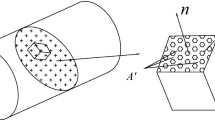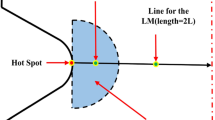Abstract
Fatigue fracture is one of the most common failure modes of engineering components, and the combined action of geometric discontinuity and multiaxial loading is more likely to cause severe fatigue damage of components. This work focuses on the fatigue behavior of U-notched Q345 steel specimens with different notch sizes under proportional cyclic tension–torsion. Firstly, based on the concept of strain energy, the calculation method of critical plane is given and the equivalent stress of the specified path on the critical plane is extracted to characterize the equivalent stress distribution state and the stress gradient effect. Then, based on the high stress volume method and theory of critical distance, a simple method for determining the critical distance is given considering the contribution of stress at the dangerous point and the critical point. In addition, based on the idea of stress–distance normalization, a new stress gradient impact factor is defined and a new method for predicting the multiaxial fatigue life of notched specimens is given. The prediction results of the proposed model, the local stress–strain method and the point method of theory of critical distance are compared with the experimental results. The comparisons show that the prediction results of the proposed model are closer to experimental life, and the calculation accuracy is higher.








Similar content being viewed by others
References
Branco R, Prates PA, Costa JD. Rapid assessment of multiaxial fatigue lifetime in notched components using an averaged strain energy density approach. Int J Fatigue. 2019;124:89–98.
Liao D, Zhu SP. Energy field intensity approach for notch fatigue analysis. Int J Fatigue. 2019;127:190–202.
Tanaka K, Akiniwa Y. Fatigue crack propagation behavior derived from S–N data in very high cycle regime. Fatigue Fract Eng Mater Struct. 2002;25(8–9):775–84.
Luo P, Yao WX, Wang YY, Li P. A survey on fatigue life analysis approaches for metallic notched components under multi-axial loading. J Aerosp Eng. 2019;233:3870–90.
Zeng Y, Li MQ, Zhou Y, Li N. Development of a new method for estimating the fatigue life of notched specimens based on stress field intensity. Theor Appl Fract Mech. 2019;104:1–14.
Matteo B, Ciro S. Mean stress and plasticity effect prediction on notch fatigue and crack growth threshold, combining the theory of critical distances and multiaxial fatigue criteria. Fatigue Fract Eng Mater Struct. 2019;42(6):228–1246.
Liao D, Zhu SP, Qian GI. Multiaxial fatigue analysis of notched components using combined critical plane and critical distance approach. Int J Mech Sci. 2019;2019(160):38–50.
Taylor D, Bologna P, Knani KB. Prediction of fatigue failure location on a component using a critical distance method. Int J Fatigue. 2000;22(9):735–42.
Neuber H. Theory of notch stresses: principles for exact stress calculation. Ann Arbor: Edwards Brothers, Inc; 1946.
Re P. Notch sensitivity. Metal fatigue. New York: McGraw-Hill; 1959.
Taylor D. Geometrical effects in fatigue: a unifying theoretical model. Int J Fatigue. 1999;21(5):413–20.
Bellett D, Taylor D, Marco S. The fatigue behaviour of three-dimensional stress concentrations. Int J Fatigue. 2005;27(3):207–21.
Susmel L, Taylor D. A critical distance/plane method to estimate finite life of notched components under variable amplitude uniaxial/multiaxial fatigue loading. Int J Fatigue. 2011;38:7–24.
Wu ZR, Hu XT, Song YD. Estimation method for fatigue life of notched specimen under multi-axial loading. J Eng Mech. 2014;31(10):216–21 ((in chinese)).
Liu JH, Ran Y, Xie LJ, Xue WZ. Multiaxial fatigue life prediction method of notched specimens considering stress gradient effect. Fatigue Fract Eng Mater Struct. 2021;44:1406–19.
Naik RA, Lanning DB, Nicholas T. A critical plane gradient approach for the prediction of notched HCF life. Int J Fatigue. 2004;27(5):481–92.
Lanning DB, Nicholas T, Haritos GK. On the use of critical distance theories for the prediction of the high cycle fatigue limit stress in notched Ti-6Al-4V. Int J Fatigue. 2004;27(1):45–57.
Huang J, Yang XG, Shi DQ. Low cycle fatigue life prediction of notched DZ125 component based on combined critical distance-critical plane approach. J Mech Eng. 2013;49(22):109–15 ((in chinese)).
Susmel L, Taylor D. An elasto-plastic reformulation of the theory of critical distances to estimate lifetime of notched components failing in the low/medium-cycle fatigue regime. J Eng Mater Technol. 2010;132(2):21–8.
Shen JB, Tang DL. Predicting method for fatigue life with stress gradient. Chin J Mech Eng. 2017;28(01):40–4 ((in chinese)).
Zhu SP, Ai Y, Liao D, Correia JAFO. Recent advances on size effect in metal fatigue under defects: a review. Int J Fract. 2021. https://doi.org/10.1007/s10704-021-00526-x.
Lukas P, Kunz L. Notch size effect in fatigue. Fatigue Fract Eng Mater Struct. 1989;12(3):175–86.
Kuguel R. A relation between theoretical stress concentration factor and fatigue notch factor deduced from the concept of highly stressed volume. Proc ASTM. 1961;61:732–48.
Torrent RJ. A general relation between tensile strength and specimen geometry for concrete-like materials. Mater Constr. 1977;10(4):187–96.
Lin CK, Lee WJ. Effects of highly stressed volume on fatigue strength of austempered ductile irons. Int J Fatigue. 1998;20(4):301–7.
Wang YR, Li HX, Yuan SH. Method for notched fatigue life prediction with stress gradient. J Aero Power. 2013;28(06):1208–14.
Acknowledgements
This research was supported by the National Natural Science Foundation of China (Grant No. 51605212), the Natural Science Foundation of Gansu Province (Grant No. 20JR10RA161), and the Project of Hongliu Excellent Youth Program of Lanzhou University of Technology (Grant No. 2020062001).
Author information
Authors and Affiliations
Corresponding author
Rights and permissions
About this article
Cite this article
Liu, J., Pan, X., Li, Y. et al. A Two-point Method for Multiaxial Fatigue Life Prediction. Acta Mech. Solida Sin. 35, 316–327 (2022). https://doi.org/10.1007/s10338-021-00287-z
Received:
Revised:
Accepted:
Published:
Issue Date:
DOI: https://doi.org/10.1007/s10338-021-00287-z




